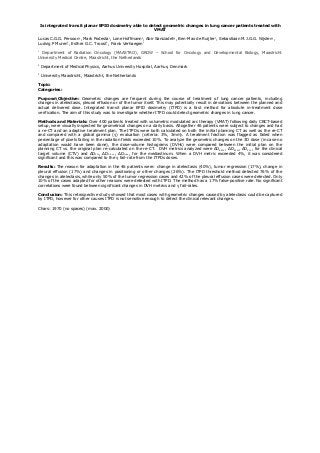
20150326_BigART_2K15_abstract_final.docx
- 1. Is integrated transit planar EPID dosimetry able to detect geometric changes in lung cancer patients treated with VMAT Lucas C.G.G. Persoon1 , Mark Podesta1 , Lone Hoffmann2 , Abir Sanizadeh1 , Ben-Max de Ruijter3 , Sebastiaan M.J.G.G. Nijsten1 , Ludvig P Muren2 , Esther G.C. Troost1 , Frank Verhaegen1 1 Department of Radiation Oncology (MAASTRO), GROW – School for Oncology and Developmental Biology, Maastricht University Medical Centre, Maastricht, the Netherlands 2 Department of Medical Physics, Aarhus University Hospital, Aarhus, Denmark 3 University Maastricht, Maastricht, the Netherlands Topic: Categories: PurposeObjective: Geometric changes are frequent during the course of treatment of lung cancer patients, including changes in atelectasis, pleural effusion or of the tumor itself. This may potentially result in deviations between the planned and actual delivered dose. Integrated transit planar EPID dosimetry (ITPD) is a fast method for absolute in-treatment dose verification. The aim of this study was to investigate whether ITPD could detect geometric changes in lung cancer. Methods and Materials: Over 400 patients treated with volumetric modulated arc therapy (VMAT) following daily CBCT-based setup, were visually inspected for geometrical changes on a daily basis. Altogether 46 patients were subject to changes and had a re-CT and an adaptive treatment plan. The ITPDs were both calculated on both the initial planning CT as well as the re-CT and compared with a global gamma (γ) evaluation (criteria: 3%, 3mm). A treatment fraction was flagged as failed when percentage of pixels failing in the radiation fields exceeded 10%. To analyze the geometric changes on the 3D dose (in case no adaptation would have been done), the dose-volume histograms (DVHs) were compared between the initial plan on the planning CT vs. the original plan re-calculated on the re-CT. DVH metrics analyzed were ΔD98%, ΔD95%, ΔD5%, for the clinical target volume (CTV) and ΔD2%, ΔD0.5cc, ΔDmax, for the mediastinum. When a DVH metric exceeded 4%, it was considered significant and this was compared to the γ fail-rate from the ITPDs doses. Results: The reason for adaptation in the 46 patients were: change in atelectasis (40%), tumor regression (17%), change in pleural effusion (17%) and changes in positioning or other changes (26%). The ITPD threshold method detected 76% of the changes in atelectasis, while only 50% of the tumor regression cases and 42% of the pleural effusion cases were detected. Only 10% of the cases adapted for other reasons were detected with ITPD. The method has a 17% false-positive rate. No significant correlations were found between significant changes in DVH metrics and γ fail-rates. Conclusion: This retrospective study showed that most cases with geometric changes caused by atelectasis could be captured by ITPD, however for other causes ITPD is not sensitive enough to detect the clinical relevant changes. Chars: 1970 (no spaces) (max. 2000)